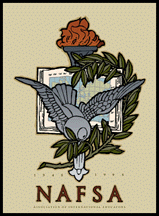 (#176) NAFSA http://nafsa.org/:
(#176) NAFSA http://nafsa.org/:
Edition of 1841 of which 125 copies are signed 1-125, 26 copies are signed A-Z as artist's proofs; 21 are signed as dedication copies, and three sets are signed as progressives.
 (#176) NAFSA http://nafsa.org/:
(#176) NAFSA http://nafsa.org/:
Edition of 1841 of which 125 copies are signed 1-125, 26 copies are signed A-Z as artist's proofs;
21 are signed as dedication copies, and three sets are signed as progressives.
March 26, 1998 17" x 24" Eleven colors
Client: A. Lee Ziegler (415) 563-9072, Association of International Educators, 1875 Connecticut Avenue, NW, Suite 1000 Washington DC 20009-5728 (202) 462-4811 e-mail: inbox@nafsa.org
The first bird that Noah sent out from the ark was a raven, and it did not return to him. It went to and fro until the waters were dried up from off the earth, and then it had a feast. There were, after all, the bodies of every living thing-man, and cattle, and the creeping things, and the fowl of the heaven-lying there exposed by the receding waters that had destroyed them, and there was no reason for the carrion bird to go anywhere. Noah also sent forth a dove, which found no rest for the sole of her foot, and returned, and Noah put forth his hand and took her, and drew her into the ark. After a wait of seven days, Noah sent the dove again. It returned to the ark in the evening, with an olive leaf plucked off, and by this sign Noah understood that the waters were abated. He waited yet another seven days, and sent forth the dove again, and it did not return. And God set a rainbow in the storm cloud as a symbol of a covenant between Him and His creatures that He would not destroy the Earth and its inhabitants with a flood anymore, as well as to remind Himself, when He saw His bow in the storm cloud, not to do it.
The story of Noah's Flood is about learning something. In this case, it was about God learning that there was nothing to be done with man, the work of His hands. Man was flawed because God had made him that way: "I will not again curse the ground any more for man's sake; for the imagination of man's heart is evil from his youth."
The dove came to symbolize a promise of peace between man and God. God promised not to smite again the Earth for mans' sake, nor to smite any more every thing living, because He had learned a lesson.
When we burned our fingers with atomic fire, we also presented ourselves with a lesson. From now on, if anybody smites the earth and every living thing, it will be man, and it won't be with water, but with fire. And the bird we release will be a raven, and it will not come back.
The images in the NAFSA poster are intended to transmit the concept of learning through cultural exchange.
Few images indicate the idea of learning, education and knowledge as does that of an open book. Few images imply human diversity better than a representation of the Earth. Seen from space, the Earth has no political boundary lines, and this suggested an image of the Earth as an open book displaying an unadorned map of the world.
The traditional, and universally understood symbol of the dove of peace carrying in its beak an olive branch is superimposed on and entwined with both the world-wide book of knowledge, and the torch which itself symbolizes the vital task of education. Knowledge casts out the darkness, and passed from hand-to-hand, it illuminates minds for countless generations and unimaginable futures. The torch of knowledge is kept burning as it is fed, and the best way to learn is to teach.